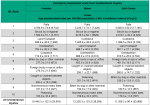Leading Causes of Unintentional Injury
Leading Causes of Unintentional Injury
Falls, land transport collisions (e.g. motor vehicle) and poisonings were the leading causes of fatal injuries in Middlesex London. Those same injuries, as well as when people ran into an object or were hit or cut by an object, were the leading cause of less severe injuries that brought people to the emergency department.
Falls were the leading cause of injury death in the Middlesex-London population for the combined years of 2010 to 2012, with an average annual rate of 16.9 per 100,000. The rate of deaths due to falls was more than double that due to poisonings (6.6 per 100,000), the next most common cause of injury related deaths. There was no significant difference in the rates of deaths due to falls between males and females (Figure 4.2.1).
Land transport collisions, such as car crashes, were the third leading cause of death in males (9.5 per 100,000) and females (2.6 per 100,000) (Figure 4.2.1).
Suffocation and drowning represent the other most common injury-related causes of death seen in the population (Figure 4.2.1).
The leading cause of injury-related emergency department visits among both males (3,235.7 per 100,000) and females (3,784.9) in Middlesex-London was falls, followed by being struck by or against an object in 2017 (Figure 4.2.2).
Land transport collisions were the third most common for females and fourth most common cause of ED visits for injury for males (Figure 4.2.2).
Males had a significantly higher rate of emergency department visits related to unintentional injuries overall than females, and in the specific categories of land transport collisions, poisonings, and being struck, pierced or crushed by objects. However, females were had a higher rate and number of falls and dog, animal or insect bite related visits (Figure 4.2.2).
Population Health Assessment and Surveillance Protocol, 2018
Last modified on: March 15, 2019
Jargon Explained
Land Transport Collision:
Land transport collisions include injuries sustained during a motor vehicle collision, whether as a driver or passenger in the vehicle, a pedestrian, a cyclist, or a motorcyclist. They also include injuries sustained on all-terrain vehicles, snowmobiles and other types of vehicles travelling on land.
Struck by or against:
This category of injuries includes being struck by a falling object, such as a rock. Sport equipment such as a ball or hockey stick are also included as well as situations where people run into other objects such as a wall. It does not include assault, intentional self-harm, collisions with other people or being struck by a car as a pedestrian.

